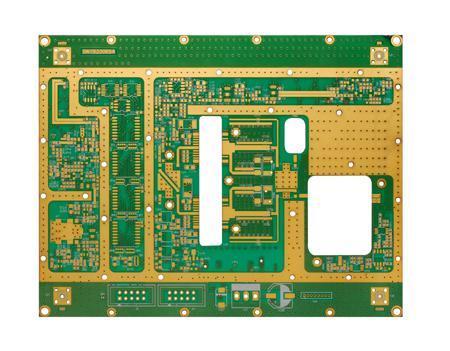1. In the design of PCB proofing, the anti-ESD design of PCB can be realized through layering, proper layout and installation. In the design process, the vast majority of design modifications can be limited to the addition or reduction of components through prediction. By adjusting the PCB layout and routing, ESD can be well prevented. The following are some common precautions.
Use multilayer PCB as much as possible. Compared with double-sided PCBs, the ground plane and power plane, as well as the tightly arranged signal line-ground spacing can reduce the common mode impedance and inductive coupling, making it 1/of the double-sided PCB. 10 to 1/100. Try to put each signal layer close to a power layer or ground layer. For high-density PCBs with components on the top and bottom surfaces, short connection lines, and many filling grounds, you can consider using inner layer lines.

For PCB proofing, it is necessary to use closely intertwined power and ground grids. The power line is close to the ground line, and as many connections as possible between the vertical and horizontal lines or the filled area. The grid size on one side is less than or equal to 60mm. If possible, the grid size should be less than 13mm.
to ensure that each circuit is as compact as possible.
Put all the connectors aside as much as possible.
If possible, lead the power cord from the center of the card and keep it away from areas that are directly affected by ESD.
On all PCB layers below the connector that leads to the outside of the chassis (which is easy to be directly hit by ESD), place a wide chassis ground or a polygonal fill ground, and connect them together with vias at a distance of about 13mm.
Place mounting holes on the edge of the card, and connect the top and bottom pads with no solder resist around the mounting holes to the chassis ground.
2. Do not apply any solder on the pads on the top or bottom layer during PCB proofing and assembly. Use screws with built-in washers to achieve close contact between the PCB and the metal chassis/shielding layer or the support on the ground plane.
The same "isolation zone" should be set between the chassis ground and circuit ground of each layer; if possible, keep the separation distance of 0.64mm.
At the top and bottom layers of the card near the mounting holes, connect the chassis ground and the circuit ground with a 1.27mm wide wire every 100mm along the chassis ground. Adjacent to these connection points, place pads or mounting holes for mounting between the chassis ground and the circuit ground. These ground connections can be cut with a blade to keep the circuit open, or jumper with magnetic beads/high-frequency capacitors.
If the PCB proofing will not be placed in a metal chassis or shielding device, solder resist should not be applied to the top and bottom chassis ground wires of the circuit board, so that they can be used as discharge electrodes for ESD arcs.
To set a ring ground around the circuit in the following way:
(1) In addition to the edge connector and the chassis ground, a circular ground path is placed around the entire periphery.
(2) Ensure that the ring ground width of all layers is greater than 2.5mm.
(3) Connect circularly with via holes every 13mm.
(4) Connect the ring ground to the common ground of the multilayer circuit.
(5) For double panels installed in metal chassis or shielding devices, the ring ground should be connected to the common ground of the circuit. For unshielded double-sided circuits, the ring ground should be connected to the chassis ground. Solder resist should not be applied to the ring ground, so that the ring ground can act as an ESD discharge bar. Place at least one at a certain position on the ring ground (all layers) 0.5mm wide gap, so you can avoid forming a large loop. The distance between the signal wiring and the ring ground should not be less than 0.5mm.
In areas that can be directly hit by ESD, a ground wire must be placed near each signal line.
3. The I/O circuit of PCB proofing should be as close as possible to the corresponding connector.
For circuits that are susceptible to ESD, they should be placed near the center of the circuit, so that other circuits can provide them with a certain shielding effect.
Generally, series resistors and magnetic beads are placed on the receiving end. For those cable drivers that are easily hit by ESD, you can also consider placing series resistors or magnetic beads on the drive end.
A transient protector is usually placed at the receiving end. Use a short and thick wire (length less than 5 times the width, preferably less than 3 times the width) to connect to the chassis ground. The signal wire and ground wire from the connector should be directly connected to the transient protector before being connected to other parts of the circuit.
Filter capacitors should be placed at the connector or within 25mm from the receiving circuit.
(1) Use a short and thick wire to connect to the chassis ground or the receiving circuit ground (the length is less than 5 times the width, preferably less than 3 times the width).
(2) The signal wire and ground wire are connected to the capacitor first and then to the receiving circuit.